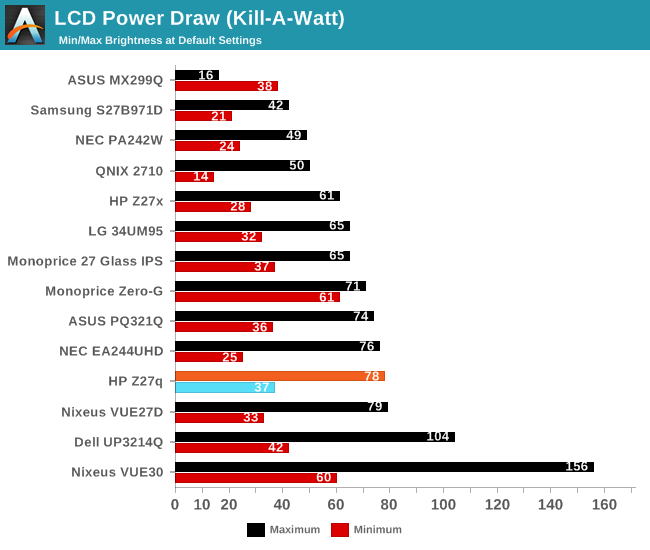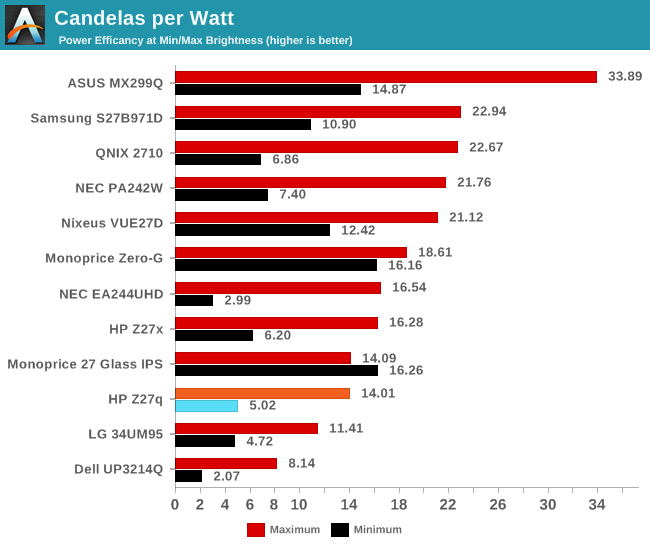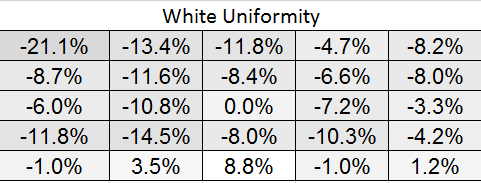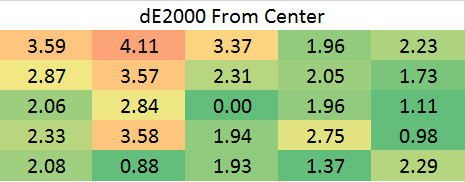HP Z27q Monitor Review: Aiming For More Pixels
by Brett Howse on December 22, 2015 8:00 AM ESTDisplay Uniformity
Having an accurate display is great, but the best displays maintain that accuracy across the entire display. This is challenging for most displays, with larger displays struggling to keep an even backlighting across the entire panel.
White Levels
The HP Z27q suffers from the same issues with uniformity that the Z27x had. There is a significant drop in brightness at the edges of the display. The maximum drop is the upper left corner, where it falls over 20% from the center. The rest of the panel is quite a bit more consistent, but some work could be done here to improve the results.
Black Levels
The black levels are even more inconsistent than the white levels, with the top of the display having the best black levels, and the bottom of the display has the brightest blacks. As a percentage basis, it’s not great.
Color Variation
The error level from the center is, on average, pretty good. There are a couple of areas where the error level is above that of something you would notice, but generally it is pretty close to the same error level as the center. Color uniformity is likely impacted by the same backlight issues that caused the white levels to drop off. Overall, the uniformity results of the Z27q are very similar to the Z27x. There is quite a bit of variation across the panel, and true professionals will likely want a display more accurate than this. At the center, it is very good, but once you move out to the edges, the backlight is quite uneven.
Power Use
Power is measured at the wall with a Kll-A-Watt meter. Measurements are done at both the maximum backlight level, and the minimum backlight level. Maximum brightness is right around 300 nits, and minimum is 51.

The display draws quite a bit of power compared to other 27-inch panels, with a maximum draw of 78 watts at 100% brightness. The minimum power draw is 37 watts, which is once again pretty high. This is not that surprising due to the resolution of this panel, since in order to hit the same brightness levels as a lower resolution display, it is going to need a more powerful backlight due to the transistors in the panel blocking more of the light.
The standby power draw was also quite high. I measured 16 watts at the wall when the display is in standby mode.
Efficiency

Once again, with the high number of pixels, this panel is not going to be as efficient as lower resolution devices. However, it is not as far off as you may think. Candelas per Watt at maximum brightness was 14.01, which is certainly lower than some of the other 27-inch devices, but not excessively so. At minimum brightness the efficiency drops to just 5.02 Candelas per Watt, and more of the power usage is shifted to the electronics of the unit rather than the backlight.















92 Comments
View All Comments
SanX - Wednesday, December 23, 2015 - link
Watch my lips: all that standard traditional PC monitor crap is dead. Monitors must be 4K 50+ inch size, period. I can not even look at that old junk after using for 6 months Samsung 50" 7100 4K TV. Despite it formally is a TV it's light years better then anything else called "PC monitor".The only defect -- it has no PnP functionality so that your PC can not switch it ON. As a result if your PC is ON and TV is off the PnP functionality of Windows may think that you changed monitor to standard resolution and move your open windows to the upper left corner. There exist software which can restore windows positions. It has one of the best latencies ~20ms so with GTX980TI class graphics card it is great for gamers too.
Zan Lynx - Wednesday, December 23, 2015 - link
I wouldn't say regular monitors are dead. I do agree that 50" 4K screens are amazing. It is exactly like having four 24" 1080p monitors in front of you without the obnoxious screen borders.AnnonymousCoward - Friday, December 25, 2015 - link
The Samsung 7100 lags 44ms in 4:4:4 mode, according to http://hardforum.com/showthread.php?t=1853884 That's totally unacceptable.SanX - Friday, December 25, 2015 - link
The only where this could be unacceptable is fast gaming for which there specially exist Game mode which halves the lag. Additional ms you get from high end graphics. Aside from games, in PC mode the 44 ms is still more then twice the human reaction time, I personally do not feel any lag at all, repeating, AT ALL. Monitor quality just overwhelms you, the wow factor is incredible. Do not look at any smaller regular monitors even 4k 28", like Samdung or ASUS, even for free, they are unacceptable in PC text use without scalingSlyNine - Friday, December 25, 2015 - link
Which means you're increasing reaction time by 50%.This would, and has, drove me nuts with tv's used as monitors.
AnnonymousCoward - Monday, December 28, 2015 - link
> more then twice the human reaction timeReaction time is different than observing feedback from your moved hand. The former requires you to interpret a stimulus and respond. The latter involves consciously moving and looking for the result. The difference is probably about a factor of 10: ~200ms reaction time, ~20ms threshold for seeing a result.
SanX - Saturday, December 26, 2015 - link
You still live with impressions of old TVs 50-100 ms lags playing games but things changed a lot.The 44ms lag for standard PC usage (browsing and programming) is absolutely great and not noticeable. For games you have Game Mode with 20-25ms lags which is not noticeable too unless you are a champion of the Republic of Gamers. No other TV monitors beat that (may be only Sammys JS7500 and the Vizio's with 18ms lag) while all Sonys, LGs etc TVs are in 33-55ms and longer range and still are used with for example Playstation for ages.
AnnonymousCoward - Sunday, December 27, 2015 - link
I easily notice 30ms lag with any mouse usage. I'm also a fast user with high acuity. I consider 20ms to be the max acceptable.Using non-4:4:4 in games is clearly a compromise.
It's not true that no other "TV monitor" beats the JU7100. check out this thread: http://hardforum.com/showthread.php?t=1874753 The Crossovers and Wasabi only lag 20ms in 4:4:4.
But hey, if you're a slow user and don't notice 44ms, that's great.
SanX - Sunday, December 27, 2015 - link
I repeat that the only where 44 ms is potentially niticeable is fast gaming, but for that exists game mode whete no one motice any lag as it is way below the human threshold. When I move mouse with as fast as possible circular motion for example I don't see any delay in position of mouse on the screen and on the table een recording this comparison on 30fps video (means it is below 33ms)Who trust your compilation from unknown sources obtained with unknown measurement methodology? Who would use unknown unrated brands? Who needs a monitor unusable for text and browsing because the monitor size MUST be 48 inch minimum to be comfortable for texts without DPI scaling, some people even claim 53 inch minimum? Those monitors you have mentioned are too small for multiple use. For gaming they are OK, for office use not, for use as a 4k TV - way too small, plus their quality is questionable.
Go to the best place which assesses all 4K monitors thoroughly for multiple use calles Rtings www.rtings.com/tv/reviews/by-usage/pc-monitor/best
AnnonymousCoward - Monday, December 28, 2015 - link
Man, you're wrong on pretty much everything :)I just told you, I NOTICE 30ms! But you still foolishly repeat 44ms can only be noticed in fast gaming. And 26ms game mode is beyond human detection. It's beyond YOUR detection, not everyone's! (is that not obvious yet?)
> Who trust your compilation from unknown sources obtained with unknown measurement methodology?
Do you have better data? Even if there's +-5ms of error, the data is immensely useful.
> Who would use unknown unrated brands?
They still use AH-IPS LG panels, and that's arguably _better_ than Samsung's VA.
> MUST be 48 inch minimum to be comfortable for texts without DPI scaling
Nope. 43" is only 103 PPI. And anything bigger is a lot less comfortable (with a normal viewing distance) since the screen is too big and you have to move your head around. Or, you get a 55" and push it farther back to prevent moving your head around, and then have an even higher effective PPI due to further viewing distance.